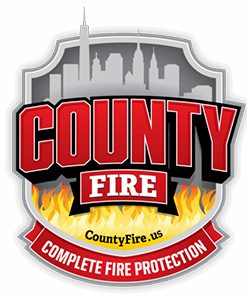Fire Supression Sprinkler System
Fire Sprinkler Inspection, Testing & Maintenance Services
Sprinkler systems form the backbone of fire suppression—automatically activating to contain flames before they spread. When combined with alarms, extinguishers, and monitoring, sprinklers create a complete fire protection system that keeps your facility compliant, protected, and ready.

Our Fire Sprinkler Solutions Include
Compliance Verification
All Local regulations
Inspection & Testing
Routine NFPA 25 inspections
Installation & Upgrades
Code-compliant system design
Full Hydrostatic Testing
Pressure integrity testing
Comprehensive Maintenance for All Sprinkler Types

We provide full inspection, testing, and maintenance services for ALL sprinkler system types:
- Wet Sprinkler Systems
- Dry Sprinkler Systems
- Deluge Sprinkler Systems
- Pre-Action Sprinkler Systems
A fire can spread in under 60 seconds—your sprinklers must be ready.
Protect your building and maintain full compliance with County Fire’s certified sprinkler services.
What is NFPA 25 Report?
NFPA 25 sets the standard for inspecting, testing, and maintaining fire sprinkler systems, crucial for building safety. Periodic inspections ensure compliance with safety regulations and identify any issues. NFPA 25 reports document inspection results, detailing findings, actions taken, and overall system condition.
These reports are vital for building owners and authorities to verify compliance, ensure system reliability, and protect lives and property.
They include key information such as inspection dates, inspector details, system components, identified deficiencies, corrective actions, and certification of compliance. Maintaining accurate NFPA 25 reports is essential for demonstrating regulatory compliance, system reliability, and effective risk management.
Check how fire sprinkler works?
Click Here to Download
Complete Your Fire Suppression System with Fire Alarms
Fire sprinklers suppress flames, but fire alarms provide early detection and occupant notification. Together, they form a complete, code-compliant fire protection system for any building.


